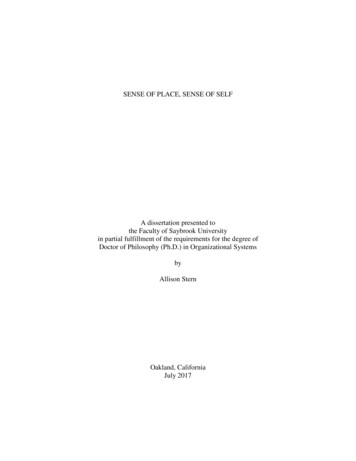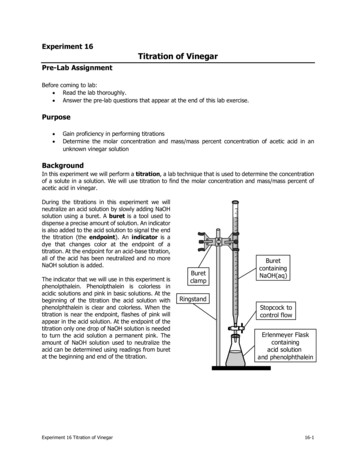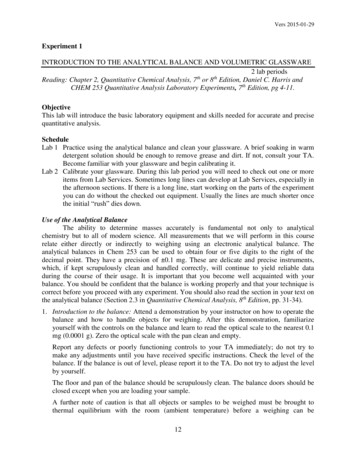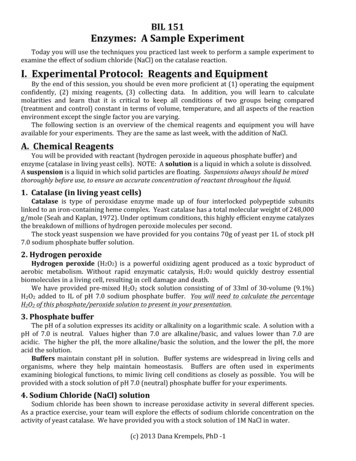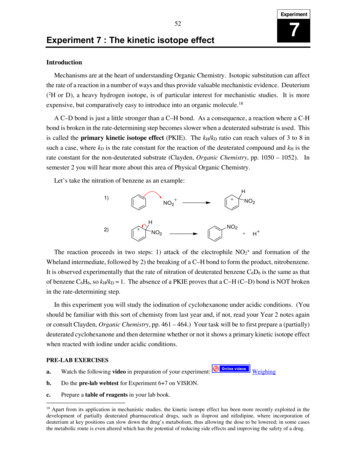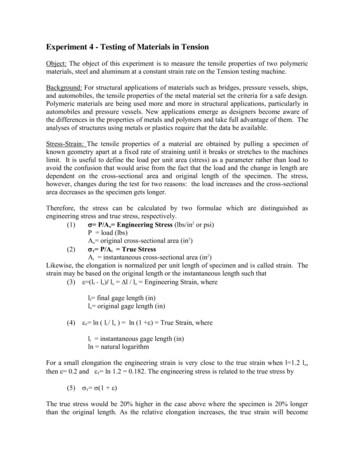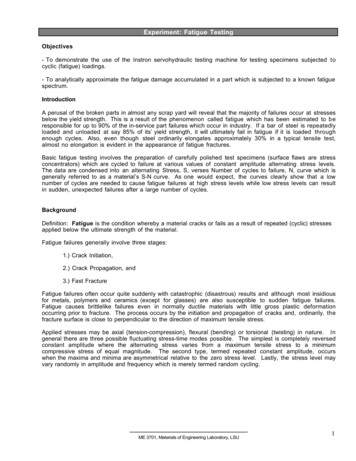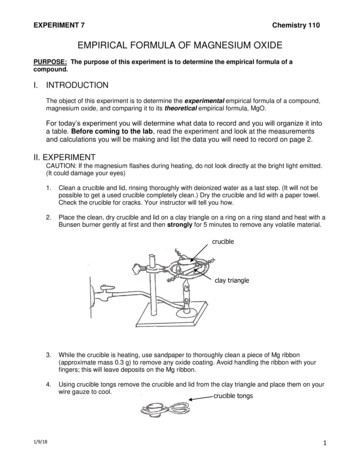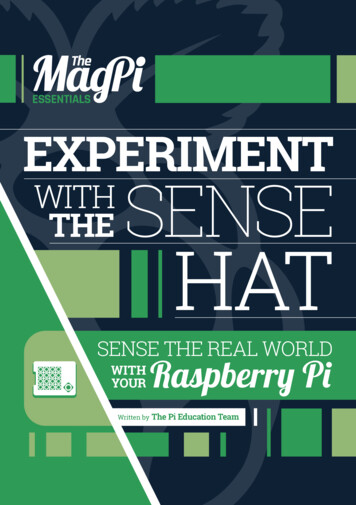
Transcription
ESSENTIALSEXPERIMENTWITHTHESENSEHATSENSE THE REAL WORLDWITHYOURWritten byRaspberry PiThe Pi Education Team
SUBSCRIBE TODAY& SAVE UP TO 25%Subscribe to the official Raspberry Pi magazine to make massive savingsSubscription benefitsPricingGet it first (before stores)Quarterly from:Free delivery to your door 12.99/ 37.50Never miss a single issueSix issues from:From 30/ 6912 issues from: 55/ 129How to subscribe:UK - ROW: 44 (0)1202 586848US - 800 428 3003Find us on your digital deviceby searching for ‘The MagPi’Visit: magpi.cc/Subs1
WELCOME TOEXPERIMENT WITHTHE SENSE HATpace exploration is fascinating andinspiring for children and adults alike.With the tiny Raspberry Pi computerhelping to change the world little-by-little, it wasonly a matter of time before it went to space tohelp out there as well. This new adventure is calledthe Astro Pi project. To help the Raspberry Pi inits extraterrestrial mission, the Sense HAT wascreated to provide more functionality; the SenseHAT board sits on top of the Raspberry Pi, and haslights and sensors to allow the Pi to interact withthe outside world.In this book, we aim to help you figure outexactly what the Sense HAT is and how you coulduse it to make your projects and dreams a reality.It’s an incredibly versatile and flexible bit of kitwith plenty of very obvious uses, along with manymany less-obvious ones, that you’ll love to makeand share.SRob ZwetslootFeatures Editor, Raspberry PiFIND US ONLINE BSCRIPTIONSManaging Editor: Russell Barnesrussell@raspberrypi.orgFeatures Editor: Rob ZwetslootSub Editors: Laura Clay, Phil King, Lorna LynchSeymour Distribution Ltd2 East Poultry Ave,LondonEC1A 9PT 44 (0)207 429 40003GET IN TOUCH magpi@raspberrypi.orgIn print, this product is made using papersourced from sustainable forests andthe printer operates an environmentalsystem[ managementChapter One] which has beenassessed as conforming to ISO 14001.Critical Media: criticalmedia.co.ukHead of Design: Dougal MatthewsDesigners: Lee Allen, Mike KayIllustrator: Sam AlderSelect Publisher Services LtdPO Box 6337, BournemouthBH1 9EH 44 (0)1202 586 848magpi.cc/Subs1This book is published by Raspberry Pi (Trading) Ltd., Mount Pleasant House, Cambridge, CB30RN. The publisher, editor and contributors accept no responsibility in respect of any omissions orerrors relating to goods, products or services referred to. Except where otherwise noted, contentin this product is licensed under a Creative Commons Attribution-NonCommercial-ShareAlike 3.0Unported (CC BY-NC-SA 3.0).
[ EXPERIMENT WITH THE SENSE HAT ]ESSENTIALSCONTENTS[ THE PIEDUCATIONTEAM ]05 [ CHAPTER ONE ]WHAT IS THE SENSE HAT?Learn why you should be excited.09 [ CHAPTER TWO ]HIGH FLIERSThe Astro Pi mission in full.21 [ CHAPTER THREE ]GETTING STARTED WITHTHE SENSE HATLearn how to use your new Sense HAT34 [ CHAPTER FOUR ]GRAVITY SIMULATORCats on the moon need gravity too39 [ CHAPTER FIVE ]MAKE A DIGITALMAGIC 8 BALLShake up your fortune44 [ CHAPTER SIX ]INTERACTIVE PIXEL PETA digital pet all of your own53 [ CHAPTER SEVEN ]ASTRONAUT REACTIONS GAMEAre you as fast as a trained astronaut?57 [ CHAPTER EIGHT ]SENSE HAT DATA LOGGERKeep a record of your surroundingsSome of thearticles you’reabout to read werecreated by thefantastic RaspberryPi educationteam, a selectionof excellentindividuals wholove to teachteachers how touse the RaspberryPi. As well asseeing their workat Picademiesaround the world,they also writeteaching materialswhich can befound online andin The MagPimagazine. You canread many moreof their tutorialsand lessons on theResources sectionof the RaspberryPi website:raspberrypi.org/resources[ Don’t[ ContentsPanic ]4
ESSENTIALSESSENTIALSONE ]WHAT IS THE[ CHAPTERSENSE HAT?The special add-on to the Raspberry Pi that lets itinteract more with the world around, as seen on the ISS!5[ Chapter One ]
[ EXPERIMENT WITH THE SENSE HAT ]he Raspberry Pi can do a lot of things thanks to its size,portability, and ability to connect to the internet easily. Withthe GPIO ports you can control electronics and interact withthe world. One of the best ways of doing this is by using an add-on likethe Sense HAT.The Sense HAT is a very sophisticated add-on board for the RaspberryPi. While HAT is an acronym (Hardware Attached on-Top), it does act ina way like a hat for your Raspberry Pi. The Sense HAT contains a suite ofsensors that allows the Raspberry Pi to sense the world around it, alongwith an array of LEDs on top which can be used to display informationon what the board can sense, and a little joystick.The Sense HAT is a vital component of the Astro Pi, the speciallyadapted educational Raspberry Pis which were sent up to the InternationalSpace Station with British ESA astronaut Tim Peake to run code created bychildren.This wasn’t what the HAT was originally designed for, though, asthe Sense HAT’s Project Lead Jonathan Bell explains:“I sort of hijacked a pet project of James [Adams’s] and turned it intoa space-faring board,” says Jonathan. James Adams is the Director ofHardware at Raspberry Pi, and along with Jonathan, was one of themain driving forces behind the Sense HAT.T[ What is the Sense HAT? ]6
ESSENTIALSAbove BritishESA astronautTim Peake, whowill be using theSense HAT on theISS for variousexperimentscreated byschool children7“Effectively we wanted toproduce a board that would be aneat, fun example of how to designa HAT” Jonathan continued. “Itwas an exercise in how to designa HAT which could be put intomass-production: how wouldsomebody go about doing that sohundreds of thousands of HATscould be made, and how would wedesign the board to deal with that.”Half-way through development,what was once a relatively basicHAT had some sensors added to it,similar to the kind used on mobilephones. “Eventually we said,hang on a minute, what happensif we put loads of sensors on thisthing and turn it into a kind ofa cool toy!”When the Sense HAT waseventually completed, it had three key sensors: separate pressureand humidity sensors that can also both measure temperature, anda motion sensor that contained an accelerometer, a gyroscope, and amagnetometer. As mentioned before, these sensors are joined by the 8x 8 LED screen and the joystick.Each sensor, the LED screen, and the joystick can all workindependently of each other as well as all together at once. You couldsimply have the LED screen display little images for you, or have theSense HAT keep track of the temperature throughout the day; it’s veryflexible to use!All of this is accessible on the Raspberry Pi by just popping the SenseHAT on top of the the GPIO pins and using the right Python code,which is what the space-bound Astro Pis on the ISS are doing.“The Astro Pi experiments make good use of the HAT itself,” Jonathantold us. “Some of them in quite unusual ways. We have a few Easter eggsup there, which you’ll have to find out about, but there have been someingenious uses of the sensors. One of the experiments that caught our[ Chapter One ]
[ EXPERIMENT[ EXPERIMENTWITHWITHTHETHESENSESENSEHATHAT] ]eye in terms of sensing was one that attempted to detect an astronaut.The astronaut detector sits there, monitoring the humidity, and ifthere is a certain percentage change in humidity in the module itthinks there’s an astronaut present. It flashes a message on the LEDmatrix saying “Are you there?”.The Astro Pis also have a special metal case which allows them (aftera few other tweaks to the Raspberry Pi) to be spaceworthy, and we’lltalk much more about that in the section about the Astro Pi. A wholehost of experiments designed by British school children went up withthe Pi for Tim Peake to use, and the data from those experiments whichmake use of the Sense HAT will be sent down to Earth.The Sense HAT is capable of many things thanks to inventive useof the sensors or even just the code that controls it, and in this specialdigital edition we hope to inspire you to create some cool projects ofyour own.The Sense HAT costs 23/ 39.95 and can be bought from theSwag Shop (magpi.cc/SenseHAT), Adafruit (magpi.cc/1TGGFy6)or from any other distributor listed on the Raspberry Pi website(magpi.cc/1TGGUt5).The LED matrix is a seriesof 64 independentlyprogrammable lightsThe Sense HAT fits neatlyon top of the RaspberryPi’s GPIO pinsBelow The SenseHAT is quite small,but packs a largenumber of sensorsand featuresThe various sensors can beused to detect environmentalvariables in the surroundingThe joystick can beused for inputs fromthe SenseHAT[ What is the Sense HAT? ]8
ESSENTIALSESSENTIALS[ CHAPTERTWO ]HIGH FLIERSBritish ESA astronaut Tim Peake isn’t the only Brit aboard theInternational Space Station. David Crookes looks at how the Pi gotinto the sky and what it means for future generations.9[ Chapter TwoOne ]
[ EXPERIMENT WITH THE SENSE HAT ]n 15 December, British ESA astronaut Tim Peake madehistory as the first British astronaut to visit the InternationalSpace Station. For the next six months, he will achievemost children’s dreams as he lives and works 400 kilometres abovethe Earth to carry out a comprehensive science programme duringa mission called Principia.His role will be to run experiments using the unique environmentof space and to try new technologies that may become crucial whenhumans begin to visit other planets such as Mars. But he will not bealone. Aside from living with five international colleagues, all of whomhave spent years training for their difficult roles, Tim was greeted byanother Brit, one set to accompany him throughout the whole of histime away from Earth.That extra ‘colleague’ is, of course, the British‑made Raspberry Piwhich, by the time Tim set off on a Soyuz spacecraft from Russia’sBaikonur cosmodrome in Kazakhstan, was already be waiting on boardthe ISS. Two Raspberry Pis were flown skywards on a Cygnus cargofreighter on 6 December, going ahead of Tim thanks to a lack of room onthe Soyuz flight. But that meant the computers were ready and waitingto be unboxed by the time Tim arrived.The Raspberry Pi’s space adventure is referred to as the Astro Pimission and, while it hasn’t been an easy ride for those involved, itcertainly has been rewarding. That’s because the computers have eachO[ High Fliers ]10
ESSENTIALSASTRO PI UP CLOSE01 The most noticeablepart of the Astro Piassembly is the 8 8 RGBLED matrix on the SenseHAT. It has a 60fps refreshrate and 15-bit colourresolution.02 The all-in-onegyroscope, accelerometer,and magnetometer willmeasure the orientationof objects, an increase inspeed, and the strength anddirection of a magnetic field.03 A temperature and humiditysensor not only measures hot andcold, but the amount of watervapour in the air. It can detectwhether a person is standingclose by, for instance.04 The barometric pressure sensoris able to measure the force exertedby small molecules in the air.05 The graphics are05driven by this microcontroller.04020603080706 To allow the astronautsto navigate the screen and options,there is a five-button joystick whichallows for up, down, left, and rightmovements, as well as an Enter viaa click.07 This hole allows air to enterthe Astro Pi device, whereit can be detected by thesensors and tested.0108 The actual casing is made fromaerospace-grade aluminium and issaid to have cost 3,000 to make.091009 As well as the various specialcomponents of the Sense HAT, theusual functions of the Raspberry Piare used. This is the power socket.10 Here we see the variousconnections of the Raspberry Pi,from USB sockets to LAN.11[ Chapter TwoOne ]
[ EXPERIMENT[ EXPERIMENTWITHWITHTHETHESENSESENSEHATHAT] ]been equipped with Sense HAT expansion sensor board, and havebeen placed inside a cutting-edge aerospace case that has been builtto withstand any conditions space will throw at it. As well as allowingthe Raspberry Pi to measure the ISS’s environment, follow its journeythrough space, and pick up the Earth’s magnetic field, the mission willgive schoolchildren the chance to have their code run in space for thefirst time ever. And that, says Tim, is proving to be most exciting of all.“[Astro Pi] has got a great sensor suite with temperature, pressure,humidity sensors, all sorts of things on it,” he told BBC television’sThe One Show following the final press conference on 6 November. “So,the schoolkids basically coded programs that I’m going to run on boardthe Space Station, and this Astro Pi is going to be in various differentmodules running an experiment each week. I’m going to send downthe data so that during the mission they can see [it], see what they’vemanaged to achieve, and if they need to modify the code, they can sendit back up to me.”The Astro Pi was the brainchild of the UK Space Agency and theRaspberry Pi Foundation, although according to David Honess, theFoundation’s education resource engineer, it was “a case of beingin the right place at the right time”. Libby Jackson, the UK SpaceAgency’s astronaut flight education programme manager, was lookingat ways to encourage children to think about the applications for spaceTim Peake (far right)attends the finalpress conferencebefore launch[ High Fliers ]12
ESSENTIALSand the ISS. “When I was applying for my current role, the candidateswere asked to prepare an idea for an activity that could inspire kids andat the time I knew about the Raspberry Pi,” she says. “I didn’t take thatidea to the interview because I didn’t know enough and I was afraid I’dbe asked questions I couldn’t answer.”The idea remained with her and when she was talking with UKSpace, the UK space industry’s trade association, she confessed shecouldn’t shake away the idea of having fun with the Raspberry Pi.“As it happened, someone mentioned that they had been talkingThe UK space industry wants to ensurethat there are enough people in thefuture to hire to carry on.to Eben Upton, the CEO of the Raspberry Pi Trading company, and sohad a point of contact. A meeting was
ESSENTIALS [Chapter One ] 01 The most noticeable part of the Astro Pi assembly is the 8 8 RGB LED matrix on the Sense HAT. It has a 60fps refresh rate and 15-bit colour resolution. 02 The all-in-one gyroscope, accelerometer, and magnetometer will measure the orientation of objects, an increase in speed, and the strength and direction of a magnetic field. ASTRO PI UP CLOSE 03 01 04 02 05 06 08 .
